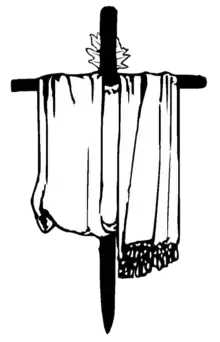Klila
In Mandaeism, the klila (Classical Mandaic: ࡊࡋࡉࡋࡀ) is a small myrtle (asa) wreath or ring (translated as "circlet" by E. S. Drower[1]) used during Mandaean religious rituals. The klila is a female symbol that complements the taga, a white crown which always takes on masculine symbolism.[2][3]
| Part of a series on |
| Mandaeism |
|---|
 |
| Religion portal |
%252C_Maysan%252C_Iraq_-_Mar_17%252C_2019_10.jpg.webp)
The klila is used to adorn the drabsha, a wooden cross covered with a white cloth that is the main symbol of Mandaeism.[2]
Use in rituals
The klila is used during most Mandaean rituals, including masbuta, masiqta, and priest initiation rituals.[2]
In the Qolasta
Several prayers in the Qolasta are recited when consecrating and putting on the klila, including prayers 19, 46, 47, 61, and 79.[1]
In E. S. Drower's version of the Qolasta, prayers 305-329 are recited for the klila, as well as for the taga.[1]
Hazazban (or Haza-Zban) is mentioned in Qolasta prayers 19 and 27 as an uthra who sets wreaths (klila) upon the heads of Mandaeans who are performing masbuta.[1]
See also
References
- Drower, E. S. (1959). Canonical Prayerbook of the Mandaeans. Leiden: E.J. Brill.
- Buckley, Jorunn Jacobsen (2002). The Mandaeans: ancient texts and modern people. New York: Oxford University Press. ISBN 0-19-515385-5. OCLC 65198443.
- Drower, Ethel Stefana (1937). The Mandaeans of Iraq and Iran. Oxford at the Clarendon Press.
